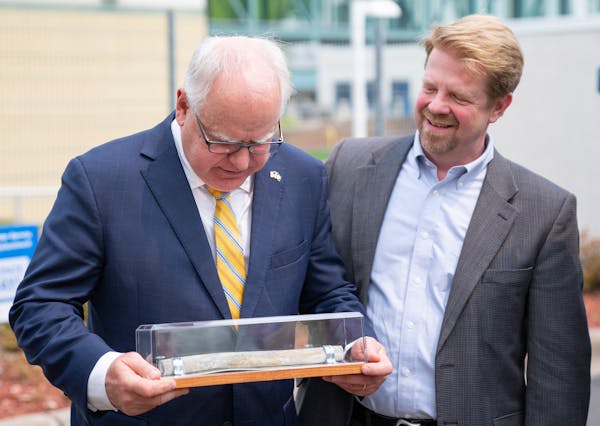Ted Thao didn't know the home he owned in St. Paul had a lead service line before the water utility called him, but the discovery came with good news — the line would be replaced, at no cost to him.
Thao's house hosts a licensed daycare, which pushed it up the priority list for St. Paul Regional Water Services' (SPRWS) lead replacement program. The new copper line that was installed this week could be a selling point for clients, Thao said, because "Everything's new, so [there's] no concern about water."
Thao is just one of 100,000 water customers across the state that the Minnesota Department of Health estimated had lead service lines in 2019. Now, $240 million in new state funds will help communities replace these toxic pipes in the next decade, as St. Paul started to do last year. An additional $215 million from the federal Infrastructure, Investment and Jobs Act will buttress the state's money over the next five years.
The massive replumbing effort comes as research increasingly shows no level of lead consumption is safe. The heavy metal is particularly harmful to growing children as it damages the brain and nervous system and causes developmental problems, according to the Centers for Disease Control and Prevention.
It has been the responsibility of property owners to maintain or replace service lines, which connect a house to the utility's water main. The cost of a replacement often comes to $8,000, according to Annika Bankston, director of water treatment and distribution for the city of Minneapolis.
The public money to replace lines will take time to reach homeowners — the state has to set up a grant process to award funding, and many cities are still catching up as they complete surveys of which homes have lead pipes and which don't.
The new funding is also going to sharply increase demand for skilled workers who are able to replace pipes. The St. Paul water utility has added 40 employees to work on lead line replacement, general manager Patrick Shea said.
The utility has been able to hire relatively easily this year, but "the extent of the work that needs to be done in Minnesota is significant," Shea said.
"We're going to need some larger construction firms to come in and partner with utilities to get this done," he added.
Finding lead
All water utilities are facing a federal deadline in October 2024 to map their lead lines. Some, like Minneapolis, are ahead of schedule — the city worked in the 2010s to digitize the paper index cards that recorded every time a home or business tapped into the system, Bankston said. The city has an estimated 47,000 lead lines.
Other communities are still completing their survey. Duluth has so far checked about a third of the city's customers, said Cyndi Falconer, who is coordinating the lead removal program. She estimated there are 9,000 lead lines in Duluth.
The job is even harder in smaller communities, said Elizabeth Wefel, a senior lobbyist for the Coalition of Greater Minnesota Cities.
"There are a lot of cities among our members that are 150 years or older, and they may not have the property records that go back that far," Wefel said.
Tom Hogan, director of the Environmental Health Division at the MDH, said the agency will work with communities to help with the inventories. The state will spend $24 million, or 10% of the fund, to find and map the lead pipes.
Homeowners who want to find out for themselves should first check with the utility to see if if there's already a map. SPRWS has a website showing them by address, and Minneapolis is working on a similar map that will be ready in June, Bankston said.
In the meantime, Minneapolis residents can call 612-673-5600 to ask about their address. Duluth notifies homeowners annually by mail that they have lead pipes if they're found at a property, Falconer said. Water customers can also call 218-730-5200.
If the pipe leading to a home's water meter is exposed, homeowners can also do a scratch test — a soft, easy-to-scratch pipe that turns a shiny silver is made of lead.
Waiting on replacements
Only cities or utilities can apply for the new state funding, so homeowners with lead lines will have to wait until their local replacement program reaches them.
Water utility directors said they try to complete projects in tandem with road work, so that a street doesn't have to be ripped up multiple times. Communities are also trying to complete the work first in places that are lower income and have higher concentrations of young children. The MDH will provide data on where children have the highest levels of lead in their blood to decide which projects come first, Hogan said.
Just because a home has a lead service line doesn't mean there's lead in the water — utilities treat the water to reduce the risk of corrosion, by changing the pH of drinking water and by using an additive that coats the inside of pipes.
Once a homeowner finds out they have a lead line, both SPRWS and Minneapolis offer free home tests to see how much lead could be in the water.
Duluth doesn't offer home tests, but will provide lead-filtering pitchers for free to customers with known or suspected lead pipes.
The best solution is to remove the lead entirely.
At Thao's house in St. Paul, workers had to dig down to the old line next to his sidewalk, pull out the old pipe, thread a new copper line into his basement and then connect it to the main, across the street.
Five hours after the work began, he could turn on the tap.

Trail section at one of Minnesota's most iconic spots closing for rehab

Will 'shotgun only' zone for deer in southern Minnesota be abolished?

Four Minnesotans catch salmonella in outbreak linked to basil sold at Trader Joe's

